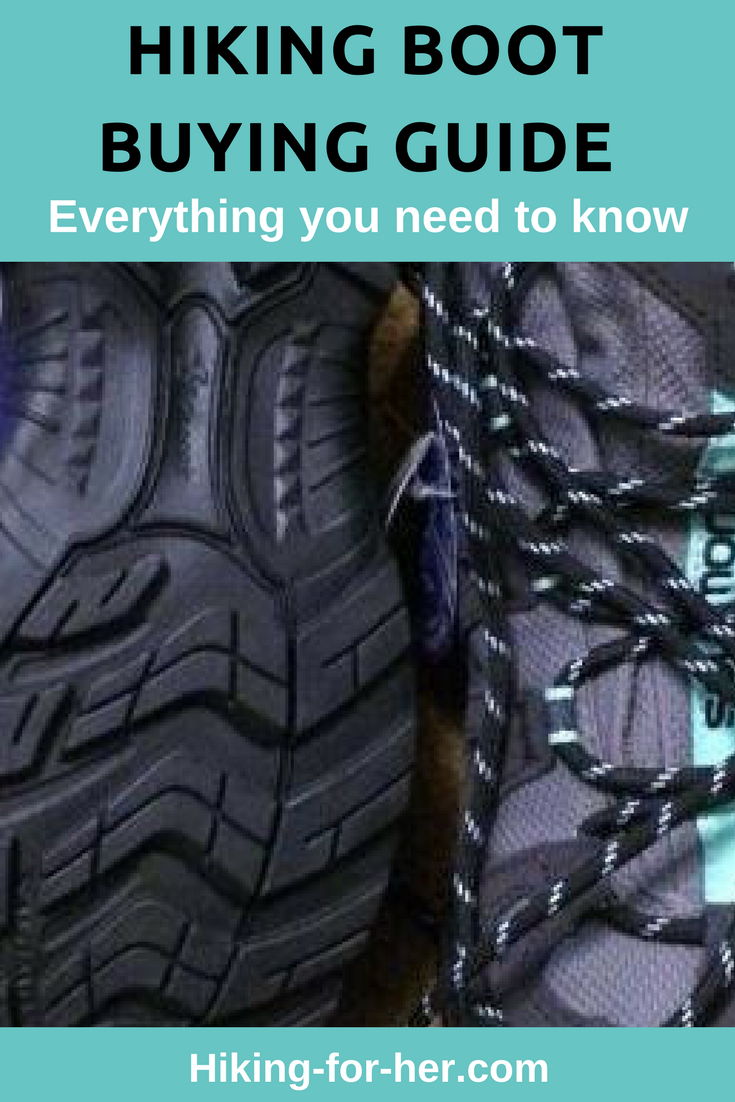What to Look for in a Hiking Boot
Hiking Boot Buying Guide:
Best Tips For Female Hikers
by Diane Spicer
Encounter Hiking For Her's Diane

This hiking kicking buying guide for women hikers gives you lot everything you lot need to know when you go shopping for the perfect pair of hiking boots for your anxiety.
It'south designed to be your go-to hiking boot guide regardless of the type of hiking yous plan to do.
In that location's a lot to say near womens hiking shoes and footwear, and boots are non equivalent to trail shoes or sandals.
So if you're looking for hiking boots, read on.
- Don't wear sandals on a hiking trail. Your feet are too important to risk bruises, cuts and other injuries.
- For tips on finding womens hiking shoes, read this.
Hiking boot buying guide
objectives
Why did I bother to write this hiking boot buying guide for women hikers?
To be helpful, of course!
It's tough to become boot shopping when you don't know your fashion around a pair of boots.
It's easy to become sucked into pretty color combinations, fancy designs on the soles, and the creative names given to hiking boots these days.
I'm hither to help you navigate!
Your objectives when boot shopping include:
- finding a pair that fit your anxiety,
- at a price you tin feel proficient almost,
- that will stand upwardly to the demands of the type of hiking trail yous choose.
- Durability and comfort on the trail should be on your listing, as well.
Hiking kick buying guide
for women'southward feet
There are three things to consider when looking at hiking boots: anatomy, hiking style, and hiking terrain.
So let's focus on each in plow in this hiking boot guide.
Foot anatomy
Anatomy separates the man species into 2 genders.
This gender rule applies even to our hiking feet, according to this commodity comparing male and female foot shape.
To summarize information technology for you, women hiker's feet are different from male hikers in these ways:
- Female person feet are not simply smaller versions of male feet.
- Male feet tend to be longer than female feet.
- Female anxiety are more than narrow.
- For women, the toe region and instep of feet are higher compared with males.
For more details about female -vs- male feet, become hither.
Then doesn't it make sense that women need to shop differently for hiking boots than their male trail buddies?
Your hiking style
You're already in the "women only" category past virtue of your birth.
But you lot tin can self-select into the category of "type of hiker", based on your planned fashion of hiking:
- Mean solar day hikers carry light packs and keep mileage and acme to reasonable numbers on each hike.
- Overnighters carry hiking camping ground equipment in improver to the ten essentials a dayhiker carries.
- Backpackers carry the heaviest packs for the longest distances. (They as well take the about fun, an stance which you tin condone entirely!)
You can bet that footwear needs to be chosen advisedly for each of these types of hiking.
And be forewarned: As y'all dabble in these different styles of hiking, your hiking footwear will aggrandize beyond just i pair of hiking shoes or boots!
Where do you hike?

The terrain you hike in also dictates what you put on your feet:
- Flat, well maintained (as in few rocks, petty to no accident downs, and bridges across streams and rivers) trails don't need a lot of foot support unless you accept a pre-existing foot status.
- Rocky, root-y, muddy trails with superlative proceeds and loss are an entirely different kettle of fish!
Quick guideline:
Ever over-buy your footwear to accommodate the worst weather you volition hike through.
Don't know yet what that looks like?
- Go for the most support and durability you can afford, while keeping in heed how heavy the boots are on your anxiety.
Go on your heart on these 3 key factors!
To summarize, at present you lot know the iii central factors to shop for when you're in the hiking boot buying frame of mind:
- Gender specific kicking features
- Type of hiking you plan to do
- Terrain you will embrace
Next upwardly in this hiking boot buying guide: a look at hiking boot construction.
Hiking boot construction:
materials
In this hiking boot buying guide discussion, zippo ranks higher than how the boots are put together.
To do a thorough job of sizing upwards a pair of boots, yous should consider how protected your feet will be.
This in turn depends on which materials are selected for the pattern of the boots.
Does this surprise you? Shouldn't fit come kickoff?
No.
Weed out the inferior boots and but try on the hiking boots that will do a good chore of supporting and protecting your feet on the trail.
Light hiking duties
If you want pes protection for day hiking and occasional overnighters, stick with hiking boots that feature combinations of nylon, split-grain leather (merely the smooth outer role of the leather is used) or suede materials.
Pros:
- Lightweight, meaning less leg fatigue
- Lower cost
- Little to no break in time
- Breathable, due to mesh panels inserted at sides or top of kick - thus, sweaty feet are less of a problem
Cons:
- Low to moderate immovability, pregnant you will demand to replace them frequently under heavy usage.
- Thus, the lower cost at the beginning might become a disadvantage if added up over many hiking seasons.
- Non waterproof unless specifically stated; look for "Gore-tex", "eVent", or "waterproof membrane".
Backpacking kick selection
If you desire hiking boots for backpacking with a heavy pack, shop for total grain leather boots.
- Yous can predict that the pros and cons will be somewhat contrary of lightweight hiking boots, correct?
Pros of full grain leather boots:
- Fantabulous durability, as in resistant to abrasions
- Lots of back up for arches and ankles
- Maximal protection from weather (temperature extremes, moisture) and terrain
Cons:
- High cost point
- Moderate to lengthy break in time, meaning you demand to wear them on several long solar day hikes before taking your first backpacking trip in them
- Not breathable, and then expect sweaty anxiety and possible accompanying foot problems including blisters, athlete'south foot, and toenail fungal infections (which are preventable but require attention)
Just a note on terminology: "nubuck" leather has been buffed to make it pretty, like suede.
This prettiness will disappear completely after a few dingy hikes, so prepare your expectations correctly.
Don't like the idea of using animals for leather?
- Read this vegan hiking boots guide.
Hiking boot construction:
outsoles
Don't spend your hard earned money on boots that don't take acceptable soles.
Later on all, soles absorber and protect your anxiety from trail hazards.
They also provide a solid grip.
Your feet deserve the best soles possible! So read on for specific hiking boot ownership guide sole tips.
Imagine yourself picking up a hiking kick.
Permit'south begin with the outsoles, what y'all see when yous turn over a hiking kick for a sole inspection:
- Is the sole stitched, or glued (cemented), to the remainder of the boot? (midsole and uppers)
- If it'southward cemented, can you see excess glue or gaps?
- If it's stitched, how far apart are the stitches?
- Lesser line: cemented means less durable; stitched ways you can replace the sole if desired. Guess which boot will cost more?
- Near hiking boots volition characteristic synthetic prophylactic fabric for outsoles.
- The more "lugs", or protruding pieces of rubber in the tread, the more traction y'all can await from the boots. Look for widely spaced lugs to get the almost traction for your coin.
- The word "Vibram" featured on the outsoles guarantees the highest amount of durability and traction. If you're looking for backpacking boots or aggressive dayhiking boots, invest in Vibram soles.
If you program to hike in rugged terrain carrying a heavy pack, you need soles that are stitched on tightly, and feature Vibram soles with an affluence of lugs.
If you're a casual dayhiker, become for cemented soles with moderate tread.
Not done yet!
Now that yous've inspected the sole on the lesser of the kicking, chosen the "outsole", you're non washed still! At that place are a few other soles to call back almost.
But starting time, to shank or not to shank.
Hiking boot buying guide:
shanks
Here'due south where trail shoes and hiking boots differ.
Boots will have a "shank" between the outsole (what you agree in your hand) and the residue of the boot.
Trail shoes, being very lightweight, skip the shank.
What exercise shanks give y'all?
Stability.
That'due south a good affair on a hiking trail! You want to keep your rest when you clamber over a downed tree, or piece of work your manner across a pile of boulders.
Shanks are created from strong materials, and may exist embedded inside the midsole (coming up side by side), or are found sandwiched between the outsole and the midsole.
Some shanks run the entire length of the boots, others only halfway.
Consider whether yous need stability for your feet, and then look for the boots that include, or omit, shanks.
Yous tin never be also sole-ful!
Midsoles
Permit'due south keep with the sandwich theme, shall nosotros?
Nosotros started on the exterior, with the outsole. (Sometimes things simply brand sense.)
The middle of the boot sandwich is aptly named the midsole.
The purpose of the midsole materials is to absorb some of the shocks of the trail before they can be transmitted up your leg bones.
Here's where things get interesting, in terms of the materials used for midsoles. A short listing of your choices include:
- Thermoplastic condom (mercifully shortened to TPR);
- Ethyl vinyl acetate (gauge at the abridgement with me: EVA);
- Polyurethane.
The detail combination, corporeality and dimension of these materials volition give your boot various degrees of daze assimilation, flexibility and immovability.
Stiff midsoles give more stupor absorption on rocky trails and nether heavy loads.
Insoles
At present allow'due south finish up with the insole.
If you stick your paw into the kicking, you're touching the insole materials.
Some boots have removable insoles, others do not.
The insole is what supports the arches of your anxiety.
By this point in your adult life, you're well aware of the shape and summit of your arches: high, low, apartment or any word yous use to describe the surface area that does not contact the insole.
You can customize the support of a hiking boot by adding inserts, either purchased at the hiking gear store or custom made for y'all (orthotics) by a podiatrist.
My best recommendation in this hiking boot ownership guide:
Spend the money information technology takes to go the best fit for your hiking boots. Your anxiety volition make or break your hiking career.
Hiking boot buying guide wrap-upwardly
Maybe this is too much information for yous.
Just perchance it's your ticket to the all-time plumbing equipment hiking boots on the planet.
I beg you to consider your options hither.
You could try on a few pair of boots, purchase the pair the "feels good", and hit the trail.
Or you could report up on how hiking boots are built, and go boot shopping armed with the facts.
I know which trail I would choose! How about you?
Even more information!
For even more than details on how to purchase hiking boots, including how to go the correct fit, read this REI commodity .
My hope is that you constitute this hiking kicking buying guide to be helpful and informative on your quest for the best hiking boots.
Still not certain you're a boot buying expert?
Ship me your hiking boot questions, using this contact link.
I answer every email I receive from hikers, because it's the only mode I take to pay back all of the wisdom and training I received when I was a younger hiker just getting started.
- And because if your feet are happy, I'm happy ;)
Home page > Best Hiking Gear >
Hiking Boot Buying Guide

About the author
Diane is the founder of Hiking For Her.
She'south been on a hiking trail somewhere in the world for 5+ decades & loves to share her best hiking tips right here.
Hiking For Her: Hiking tips you tin trust!
As an Amazon Acquaintance Hiking For Her earns from qualifying purchases.
This article was printed from Hiking-For-Her.com
Source: https://www.hiking-for-her.com/hiking-boot-buying-guide.html

0 Response to "What to Look for in a Hiking Boot"
Post a Comment